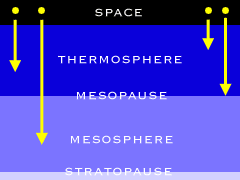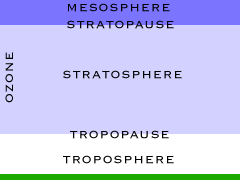A Cozy Blanket Around The Earth
 The atmosphere looks like a blanket of gas when you look at it from space or the ground. When scientists started to examine the atmosphere, they noticed that there were different parts and different layers. There are layers of different molecules, temperatures, and pressures. Overall, the atmosphere is made up of a few main molecules. The air above you is made of 78% nitrogen (N2), 21% oxygen (O2), 0.9% argon (Ar) and 0.04% carbon dioxide (CO2). That's it. The rest of it is made of things called trace elements. Those trace elements include water vapor, ozone, and other particles and molecules floating around.
The atmosphere looks like a blanket of gas when you look at it from space or the ground. When scientists started to examine the atmosphere, they noticed that there were different parts and different layers. There are layers of different molecules, temperatures, and pressures. Overall, the atmosphere is made up of a few main molecules. The air above you is made of 78% nitrogen (N2), 21% oxygen (O2), 0.9% argon (Ar) and 0.04% carbon dioxide (CO2). That's it. The rest of it is made of things called trace elements. Those trace elements include water vapor, ozone, and other particles and molecules floating around.

Thermosphere
The thermosphere is the layer closest to space. There is a huge amount of energy in this layer. The source of that energy is the solar radiation from space hitting the thermosphere. There are very high temperatures because of all the excited atoms zipping around. Something interesting you should know is that even though the temperature is very high (very excited atoms), there is actually very little heat.Heat happens when energy is transferred from one atom to another. In the thermosphere there is such a low pressure (the molecules are spread out) that there is very little heat transfer. The mesosphere is directly under the thermosphere. The mesosphere has a lower temperature and is the coldest of all the layers in the entire atmosphere.
Stratosphere
 The next layer down is the stratosphere. This is a layer with a very large temperature change. It changes from cold to warm, almost to 0 degrees Celsius (which is warm for the atmosphere).
The next layer down is the stratosphere. This is a layer with a very large temperature change. It changes from cold to warm, almost to 0 degrees Celsius (which is warm for the atmosphere).
The real importance of the stratosphere is the ozone layer. Scientists call it the ozonosphere. Those ozone (O3) molecules absorb large amount of UV (ultra-violet) radiation from the Sun. A chemical reaction takes place when an ozone molecule absorbs the UV radiation. The energy is then radiated as IR (infra-red) radiation, and that is what heats up the layer. Without the ozone, UV light would flood the surface of the Earth and the temperature of the stratosphere would be much cooler.
Troposphere
At the bottom of the atmosphere, where most of the life on the surface exists, is the troposphere. The troposphere is the only atmospheric layer that can support life. The higher layers have filtered out the harmful radiation, and there are large amounts of water vapor.This is the layer where clouds develop, birds fly, and pollution collects. Yes, the troposphere is where humans most pollute the atmosphere. It's right where we live. The pollution goes into the troposphere and rarely leaves until it falls to the ground or is mixed into the oceans. Some pollutants called CFC's make it into the stratosphere and break down the ozone layer.
Or search the sites for a specific topic.
- Overview
- Composition
- Temperature I
- Temperature II
- Pressure
- Circulation
- Interaction
- Coriolis Force
- Greenhouse Effect
- More Topics

Ozone-rich Air Descends from On High (NASA/GSFC Video)

Useful Reference Materials
Encyclopedia.com (Atmospheric Structure):http://www.encyclopedia.com/topic/atmospheric_structure.aspx
Wikipedia (Atmospheric Stratification):
http://en.wikipedia.org/wiki/Atmospheric_stratification#Principal_layers
Encyclopædia Britannica (Evolution of the Atmosphere):
http://www.britannica.com/EBchecked/topic/1703862/evolution-of-the-atmosphere





